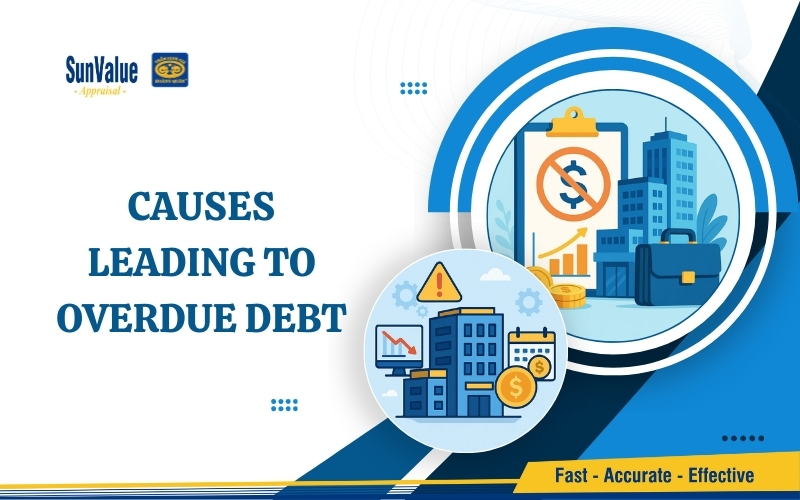In financial management, overdue debt is always an issue that causes concern for individuals, businesses and even banks. When a loan is not repaid on time, the borrower faces high penalty interest, a decline in credit credibility and the risk of litigation. For banks, overdue debt means the risk of bad debt, affecting profitability and system safety. However, overdue debt is not a “dead end.” If properly evaluated, accurately appraised and handled with appropriate solutions, this situation can completely turn into an opportunity for financial restructuring.

What is overdue debt? Identify clearly to avoid risks
According to regulations of the State Bank of Vietnam, overdue debt is a loan that is not repaid on time as stated in the credit contract. Overdue debt is usually classified into several groups: from debt requiring attention (1 – 90 days), substandard debt (91 – 180 days), to doubtful debt and debt at risk of capital loss. This is an important indicator of the borrower’s financial capacity and credibility.
Many people wonder whether being overdue by 1 day is serious. In reality, even being late by just 1 day is recorded by the banking system as a past-due status. Although it is not yet classified as bad debt, repeated occurrences will negatively affect the customer’s credit score.
For businesses, overdue debt is often identifiable through financial statements showing imbalanced cash flow, rapidly increasing interest expenses and growing repayment pressure. When a loan becomes overdue, individuals or businesses will face an overdue interest rate typically 150% higher than the original interest rate, increasing financial burden.
Common causes leading to overdue debt

Overdue debt can stem from various causes. For individuals, job loss, reduced income or overspending beyond financial capability are common reasons. Some cases arise from a lack of understanding about how overdue debt is calculated, leading to negligence in repayment.
For businesses, the main cause comes from unstable cash flow, slow customer payments, or market fluctuations. For example, during the COVID-19 period, many businesses fell into overdue bank debt because they could not rotate capital in time.
In addition, objective factors such as natural disasters, economic crises or policy changes directly impact repayment ability. Some businesses also neglect risk management and fail to set up reserve funds, causing the overdue debt situation to become more serious.
A common point among all causes is prolonged financial imbalance. If not handled early, the loan risks shifting from 30-day overdue debt to bad debt groups, resulting in long-term consequences.
Regulations on overdue debt and debt classification
According to overdue debt regulations of the State Bank of Vietnam, loans are classified into 5 debt groups based on overdue duration:
-
Group 1 debt: On-time debt, repaid as scheduled.
-
Group 2 debt: Debt requiring attention, overdue for less than 10 days.
-
Group 3 debt: Substandard debt, overdue from 10 – 90 days.
-
Group 4 debt: Doubtful debt, overdue from 91 – 180 days.
-
Group 5 debt: Debt at risk of capital loss, overdue for more than 180 days.
Many customers wonder how long overdue debt takes to become bad debt. In reality, when a loan is overdue for more than 10 days and moves to Group 3, it is recorded in the CIC credit system. From then on, customers are likely to face difficulties in taking new loans or opening credit cards.
Particularly for businesses, if the overdue debt ratio exceeds the allowable level (usually over 3% of total outstanding loans), banks will consider it high risk and limit credit issuance. Therefore, compliance with regulations and closely monitoring debt status are essential to maintaining financial stability.
Bank overdue debt handling process
When overdue debt arises, banks usually apply a multi-step overdue debt handling process to minimize risks:
-
Debt reminder notification: Banks send alerts via SMS, email or documents.
-
Negotiation with customers: Propose loan extension, restructuring or interest rate adjustment.
-
Apply penalty interest: Apply overdue interest rates typically 150% higher than normal loan rates.
-
Legal measures: If customers still fail to repay, banks may seize collateral or initiate litigation.

So, how long does overdue debt take before litigation begins? Typically, after 90 days, if negotiations fail, the bank has the right to bring the case to court.
However, customers may still negotiate for penalty interest reduction or repayment extension. In reality, can overdue debt be eligible for interest reduction? The answer is yes, but it depends on each bank’s policy and the customer’s goodwill.
Consequences and risks of prolonged overdue debt
Prolonged overdue debt causes serious consequences. For individuals, the most noticeable effect is reduced credit score, leading to difficulties in obtaining new loans. In severe cases, overdue debt becomes bad debt, limiting financial transactions for many years.
For businesses, a high overdue debt ratio directly affects credit ratings, causing loss of confidence from partners and investors. In addition, financial expenses surge due to penalty interest, reducing profit and reinvestment capability.
Another risk is legal exposure. When banks initiate litigation, businesses may have their assets frozen, affecting production and business operations. Many businesses have lost competitiveness simply because 30-day overdue debt turned into severe bad debt.
Clearly, overdue debt is not merely a financial issue; it is a determining factor in the sustainable existence and growth of both individuals and organizations.
Hoang Quan Appraisal – Optimal valuation solution for overdue debt
Overdue debt not only creates financial pressure but also directly affects the credit credibility of individuals, businesses and banks. Being late by just 1 day can trigger penalty interest; extending to 30 days risks being classified as bad debt and even facing litigation. Therefore, handling solutions must be timely, lawful and feasible.
According to the Civil Code and Circular 11/2021/TT-NHNN, individual customers and banks can negotiate debt extension, credit contract restructuring or penalty interest reduction. Businesses may sell debt to debt management companies, raise new capital or liquidate collateral. In many cases, hiring an independent consulting unit or valuation company is essential to determine the value of the debt, serving as a basis for negotiation and restructuring. Proper handling not only minimizes damage but also creates opportunities for financial recovery.

This is why Hoang Quan Apprailsal introduced the overdue debt valuation service - a comprehensive solution that helps:
-
Accurately determine the value of the debt as a basis for negotiation, restructuring or transfer.
-
Legalize documentation and ensure reports are accepted by banks and credit institutions.
-
Minimize financial risks, support optimal handling strategies and save time and costs.
-
Provide fast support, even for urgent debt or debt overdue for months.
With more than 23 years of experience and an extensive branch network, Hoang Quan Apprailsal has become a trusted partner for many banks and major enterprises in debt handling and restructuring.
Do not let overdue debt become a burden! Contact Hoang Quan Apprailsal now for free consultation and optimal solutions for your case.
Hoang Quan Appraisal Co., Ltd.
Address: Hoang Quan Appraisal System
Phone: 0934.252.707
Email: contact@sunvalue.vn
Facebook: Hoang Quan Appraisal
Website: hqa.com.vn
Conclusion
Overdue debt is a major challenge but not a “dead end.” With accurate valuation solutions and the support of a reputable unit like Hoang Quan Appraisal, customers can turn debt pressure into an opportunity for restructuring and sustainable development. Proactively handling it today is the best way to protect your credibility and financial future.

